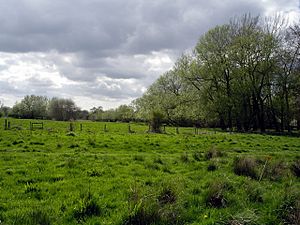Bransbury Common facts for kids
| Site of Special Scientific Interest | |
 |
|
| Area of Search | Hampshire |
|---|---|
| Interest | Biological |
| Area | 158.6 hectares (392 acres) |
| Notification | 1984 |
| Location map | Magic Map |
Bransbury Common is a special natural area in Hampshire, England. It is located south-east of the town of Andover. This area is protected because it has unique plants and habitats.
Contents
What is Bransbury Common?
Bransbury Common covers about 158.6 hectares, which is roughly the size of 220 football fields. It was officially recognized as a Site of Special Scientific Interest (SSSI) in 1984. This means it is a very important place for wildlife and nature.
Why is it a Special Scientific Interest?
A Site of Special Scientific Interest, or SSSI, is a protected area in the UK. These places are chosen because they have rare plants, animals, or interesting geology. Protecting them helps keep nature healthy and diverse for the future. Bransbury Common is important for its special plant life.
What is a Nature Conservation Review Site?
Bransbury Common is also a "Nature Conservation Review site, Grade I." This means it is one of the most important natural sites in the whole country. It helps scientists study and protect the best examples of different habitats.
Habitats and Plants at Bransbury Common
Bransbury Common has two main types of natural areas, called habitats. Each habitat supports different kinds of plants.
The Common's Unique Soil
The soil on the common is very special. It is made of a layer of peat over gravel. Peat is a type of soil formed from decaying plants, often found in wet areas. This unique soil helps specific plants grow well here.
Plants of the Peat and Gravel Areas
In these parts of the common, you will mostly find two types of grasses:
- Purple moor-grass
- Greater tussock-sedge
These plants are very common in this type of wet, peaty soil.
The Former Water Meadow
Another important habitat at Bransbury Common is a former water meadow. Water meadows are fields that were once regularly flooded by rivers. This flooding helped the grass grow for farm animals. Even though it might not be flooded anymore, the soil still holds a lot of moisture.
Beautiful Flowering Plants
The water meadow area is home to many lovely flowering plants. These flowers add bright colors to the common, especially in spring and summer. Some of the plants you might see include:
- Lady's smock (also known as cuckoo flower)
- Marsh marigold (a bright yellow flower)
- Early marsh-orchid (a type of wild orchid)
These plants thrive in the damp, rich soil of the former water meadow.

